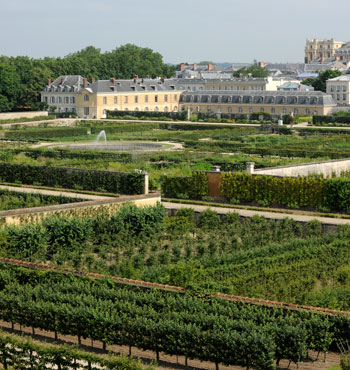

On another of my blogs, Brightmeadow on Bicycles, I am writing about my latest goal of planning and executing bicycle rides through the cities in Ohio that are named after European cities. The Grand Tour, if you will. In the 1600's and 1700's, wealthy young men, and some young ladies, were encouraged to complete a year or two travelling through the different capitals of Europe. If you have a mindset more like my husband's, you may also be familiar with the British TV show, The Grand Tour, where three journalists take trips to various globale locales to drive cars (and sometimes wreck them) through tortuous terrain. My journeys will not involve the wrecking of any bicycles.
My most recent bicycle Grand Tour trip was to Versailles, Ohio. I researched the city of Versailles, France, for contrast. Versailles is a suburb of Paris, and has much of the same cachet. Versailles was the site of the French Court during the reign of the monarchs Louis XIV through Louis XVI. And it was also the birthplace of the French Revolution.
One of the monuments of the French Palace of Versailles, a UNESCO World Heritage site, was the King's Vegetable Garden, "Le potager-du-roi" in French. It was opened to the public for tours in 1991. It's gardeners perpetuate the art of pruning and cultivate a wide variety of fruits and vegetables in a French garden.
"Louis XIV commissioned Jean-Baptiste de La Quintinie to develop a kitchen garden on the site of a swamp known as 'stinking pond'. Construction lasted from 1678 to 1683 and it had to demonstrate ingenuity to overcome the swampy terrain. This explains the use of an underground aqueduct, rubble drains and raised beds. Over time, the kitchen garden has pretty much retained La Quintinie's original design – so you will still find a succession of gardens surrounded by walls and dominated by terraces" - Versailles Tourism site
 "The soil was bad but luckily, there were plenty of horses in the King’s stables to provide tons of manure. The open land didn’t provide enough protection to heat loving fruit and vegetables. So, La Quintinie designed the garden as a series of large rooms. He dug down, improved the soil and separated areas with high stone walls and terraces to trap the sun and keep the heat in. It was innovative and exciting gardening and enabled him to grow plants that usually only thrive in the far south.
"The soil was bad but luckily, there were plenty of horses in the King’s stables to provide tons of manure. The open land didn’t provide enough protection to heat loving fruit and vegetables. So, La Quintinie designed the garden as a series of large rooms. He dug down, improved the soil and separated areas with high stone walls and terraces to trap the sun and keep the heat in. It was innovative and exciting gardening and enabled him to grow plants that usually only thrive in the far south.
It was said he could provide up to 4000 figs and 150 melons a day. Lettuces were grown in January. Strawberries were ripe in March. Coffee beans and bananas were grown, as by 1685 glass making techniques meant greenhouse conditions could be created. The underground heating kept roots healthy even in the dead of winter. Louis would show off the area to foreign visitors, it became one of the most famous gardens of its time. " from the website The Good Life France.
A fellow blogger, Jill Colonna of Mad About Macarons and Teatime in Paris wrote about her experience there. It inspired her to make a red onion Chevre Tartin. The link to her recipe on that page is no longer working, but I found her recipe elsewhere on her blog. I do not have prepared puff pastry dough on hand, but I do have flour and butter and lard. I have previously and successfully used this recipe from Penelope Casas for puff pastry, and I have some fresh black walnut meats from trees in our yard that I painstakingly picked out earlier today. I will serve with pears from our orchard.
At the moment I have two dozen or so quart canning jars in the dishwasher. Ed was able to source some jar lids from China for me. I am still waiting for the ones I ordered from Lehman's hardware. I will be canning apples picked last week in Michigan as soon as the cycle is finished.
I rode my bike on the Marion Tallgrass Trail yesterday. At each intersection along the trail, there were flowerbeds in the center of the trail, instead of the traditional bollards which warn riders of an intersection.
At the trailhead, there were some really beautiful marigolds of three different varieties. Or perhaps one variety with three different appearances. I collected a couple of dried blossoms with the seeds. I'm afraid I lost some when I took my phone out of the case, but I have put the rest in an envelope for planting next spring. I hope that some are viable! Perhaps they will hybridize and I will get something completely new.
These seed packets were waiting for me when we arrived home last night. I recently read an article about Matina tomatoes. I've been planting Bloody Butcher and Fourth of July and Independence Day salad tomatoes for the last 15 years. They are all early, small tomatoes. I rarely harvest any by the actual fourth of July, but usually have some by mid-July. I suspected that they were all really the same variety, so I did a google search to look for comparisons. Instead, I found this Matina variety that had rave reviews. Since it is so late in the season, I was afraid I would not remember the name for next year, so I went ahead and ordered this year's seeds. This is a new seed company for me. Service was fantastic, I received the seeds two days after I ordered them.
"We don’t want to make crazy, bold proclamations after so short a time of getting to know a new variety (which, as you can tell from the intro, means we are going to anyway) but Matina might be our best all-around slicing tomato. It’s nice to be a small family company where we can write something like that and not break down into staff fistfights. It just checks all the boxes for us and exceptionally so: sets very early but with sustained harvests through fall, strong vigorous growth, beautifully organized and prolific trussing, perfect blemish-free and very uniform fruit, and a great flavor balance of sweet and acid. I reckon we harvested about 400+lbs of fruit from 30 field-grown plants in the summer of 2016! At 4-6 oz, the fruits are a little larger than Stupice, slightly flattened, and just the flawless ideal of a tomato in appearance. One of Carolyn Male's “100 Heirloom Tomatoes for the American Garden” it hails from Germany, where our seed was originally sourced. This should be a nursery standard in the PNW. (Crowned taste test winner at two Organic Seed Alliance trial events of early red slicers in 2017)Indeterminate/Potato Leaf. 65-70 days. UO"
As far as the zuchini variety, it is also new to me. This year I planted Burpee's Best zuchini, Of the five hills I planted, two were excellent and healthy, the others did not do so well. I picked about 20 zuchinis, then the plants just fizzled out, dried up and turned brown.
This is the first year gardening in this garden, so I haven't added a lot of soil amendments yet. I learned that the previous owner "salted" her asparagus patch to kill weeds, and I had planted the zuchini downhill from the asparagus, so perhaps that accounts for the poor performance. From the seed company, Dark Star description:
"(C. pepo) Market growers take note. Here is a zuke to rival all the corporate-owned hybrids currently hijacking the zucchini market. Bred by Bill Reynolds of Eel River Produce in Northern CA & John Navazio, Dark Star was selected in part for vigorous root growth to excel in dry farming conditions. What struck us though is the quality of the fruit, by far the most refined OP zuke we’ve seen with very uniform long, dark green, angular fruit. While not as productive at its peak as some (though certainly no slouch), it sustained its productivity over a longer period than others we’ve grown. Open habit makes it easy to pick. Recommended for the home garden or by the acre. The best OP standard zuke on the market. (Update: during the freakish frosts in Baja in the winter of 2011 Dark Star was likely the only organic zucchini in grocery stores. Just a degree or two more cold hardiness kept it alive amidst a sea of frost killed neighboring fields)
50-55 days. SR"
